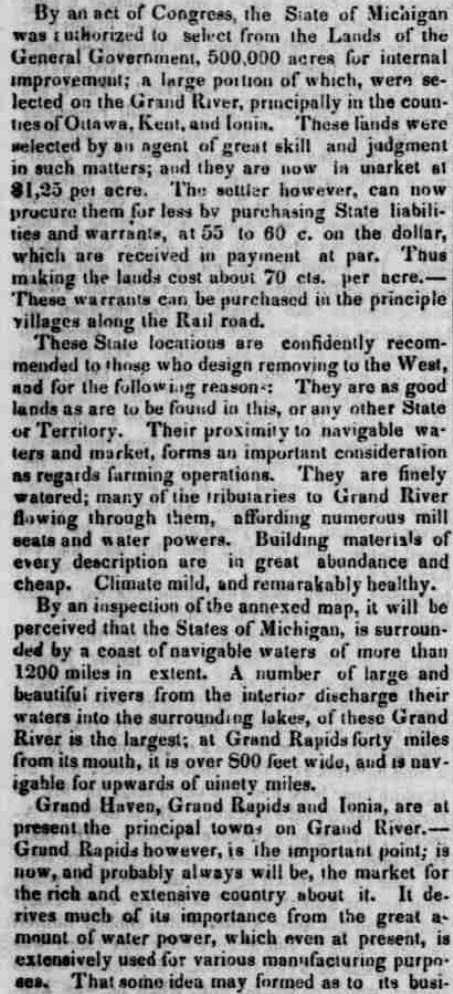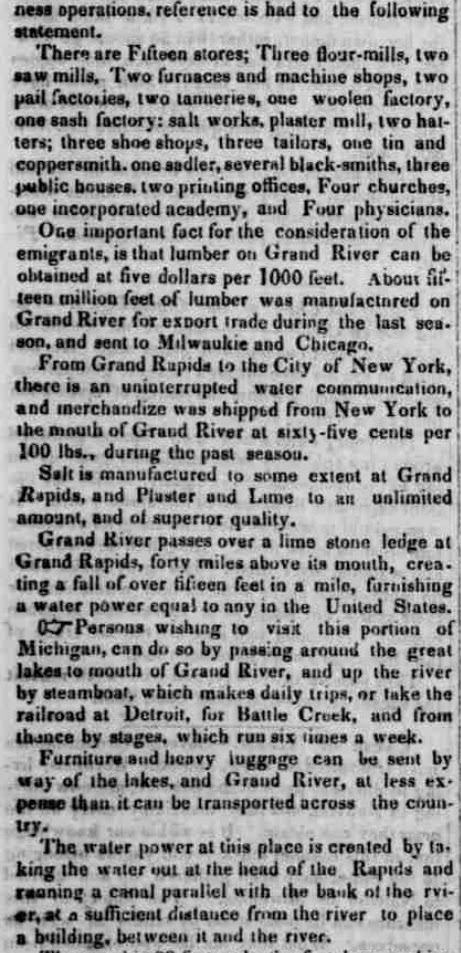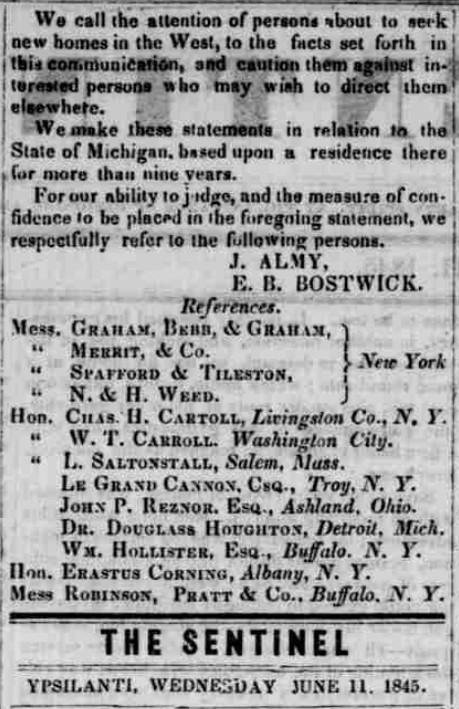The little buildings above the word Cold Brook are Charles Taylor's house and hotel. The mill is to the right. There is a large cemetery between Cold Brook and Wallbridge Streets, with Cemetery Street on the left and Livingston Street on the right. Cemetery became Taylor Street by 1876.
"In 1836-37, Dwight and James Lyman built a grist mill on Coldbrook, a little above where now is the railroad station. A man named Fish, and after him John C. Stonehouse, were millers there. In 1838 some gypsum grinding, for plaster of paris, was done at that mill. Afterward some wood turning machinery was operated in connection with it, and Charles W. Taylor put in a second set of stones. The stream did not furnish sufficient power to run it steadily in dry seasons, but this became a popular custom mill, and flour from it for home use always found ready sale. In 1861-62 it was operated by Asahel Hubbard. Some years later its use became unprofitable, and the flouring apparatus was removed. February 28, 1880, the building was blown down in a gale."
From Chapter XXXIX, Flouring Mills, Saw Mills and Lumber,
Grist Mills, Baxter's History of the City of Grand Rapids, 1891.
"Like the woolen factory, which died for lack of sheep, the pioneer tannery, established by Tanner Taylor (as he was familiarly known) upon Cold Brook, was started before there were any cattle. Nevertheless, Mr. Taylor pluckily tanned everything there was for many years, including sheep’s pelts, deer hides, horse hides, and some say woodchuck skins; and so much leather as he was able to produce was of first class quality. But the business finally died for want of material, having been a great help in its time to the early settlers, and a typical pioneer industry in the persistent pluck with which it was carried on in the face of hopeless circumstances."
From 1889 BUSINESS BEGINNINGS.HOW THE BUSINESS OF GRAND RAPIDS BEGAN AND GREW , Pioneer Pluck and Enterprize-A History Of Remarkable Achievements in the Face of Difficulties-A Story That the Old Settlers are Justly Proud Of. (Grand River Daily Eagle - 25 December 1889)
Here is the Taylor house as illustrated in Baxter, p 763.
By 1857 the area looked like this, when Charles sold it to the City of Grand Rapids:
The big reason for all the changes can be seen from the lower right to the upper middle: The Detroit and Milwaukee Railway, which was put through in 1858. The cemetery has disappeared and the area has been platted for housing and industry. There are dams for the saw mill, middle, and the grist mill, right, forming two holding ponds. The tannery has a system of canals diverting the stream for water power.
"DETROIT, GRAND HAVEN AND MILWAUKEE The first railroad incorporation within the old Northwest Territory was that of the Pontiac and Detroit Railroad, chartered by the Territorial Legislative July 31, 1830. Five years were allowed to complete the line, but, the corporators failing to carry out their projects, a new corporation, that of the Detroit and Pontiac Railroad Company, was chartered March 7, 1834. In 1835 contracts were let for clearing the line at the Detroit end, but the progress of construction was slow. In 1838 the State loaned to the company $100,000, and before the end of May in that year the road was in operation for a dozen miles. At first the cars were operated by horse power, and on wooden rails. It was opened to Pontiac in July, 1839, and as late as 1845 the cars ran on what was called the strap rail. The Detroit and Pontiac Railroad Company, chartered March 7, 1834, and the Oakland and Ottawa Railroad Company, chartered in 1848, were consolidated April; 21, 1855, under the name of the Detroit and Milwaukee Railway Company, to construct a road from Detroit to Grand Haven, a distance of 180 miles. The line west of Pontiac was completed by this company November 22, 1858, reaching Grand Rapids early in July, and the first through train from Grand Haven to Detroit passing here September 1, 1858. Trains between Grand Rapids and Detroit began running July 12, 1858. In 1860 the property was sold under foreclosure, and a reorganization under the name of the Detroit and Milwaukee Railroad Company was effected. In 1873 the new company made default in the interest on its bonds, and the road was put into the hands of C. C. Trowbridge as Receiver, April 11, 1875. September 4, 1878, it was sold to the bondholders, and in November the company was reorganized as the Detroit, Grand Haven and Milwaukee Railway Company. From the west this road crosses the lines of the Chicago and West Michigan and Grand Rapids and Indiana about half a mile north of the city limits, and crossing Grand River, bears in a southeasterly direction to the depot on Plainfield avenue and East Leonard street; thence, skirting the hills past Highland Park, leaves the city line on the east near Waring and East Bridge streets. An average monthly pay roll of $3,500 is distributed among sixty employes. Eight passenger trains are run daily. This road ever since its construction has been operated in connection with a daily line of steamers across Lake Michigan, between Grand Haven and Milwaukee. It has also made connections with steamboats plying between Chicago, Grand Haven and Muskegon. The principal officers of this railway, up to 1889, have been, since its opening to Grand Rapids: Presidents--C. J. Bridges, 1858 to 1863; C. C. Trowbridge, 1863 to 1878; S. Baker, 1878 to 1880; Frances D. Grey, 1880 to 1882; since 1882, Joseph Hickson. General Superintendents--W. K. Muir, S. R. Calloway, each for a brief period; since August, 1884, W. J. Spicer has been General Manager. Secretaries--1861 to 1864, W. C. Stephens; 1864 to 1866, Thomas Bell; since January, 1866, James H. Muir. Agents at Grand Rapids, in succession--A. B. Nourse, A. M. Nichols, J. C. McKee. W. Wallace, J. W. Orr, and since November, 1882, F. C. Stratton."

The above picture and caption appeared in Etten's A Citizen's History of Grand Rapids, Campau Centennial September 23 - 26, 1926 but I copied the picture from Robert Kline's website containing scans of the Public Museum of Grand Rapids' photo collection.
(1870) "The view up river from the hill. First Leonard street bridge, built in 1858. Right foreground, old Ionia street school. Behind the school tower is Tanner Taylor's tannery and just beyond C. C. Comstock's famous "row," first multiple apartment in city, built to house negroes who worked in Comstock mills."
Notice how dilapidated the tannery is in 1870, without a roof. Taylor's house would be out of the picture on the right.
This excerpt from Baxter explains why: "Charles W. Taylor came in 1839, and began the tanning business in a small way at Coldbrook, a short distance from the river, which he continued at the same place nearly thirty years. His tannery was burned three times, by each of which disasters he suffered a loss of upward of $10,000--first on December 16, 1851, again February 5, 1856, and the third time May 31, 1867, after which he discontinued the business."
By 1876 the mill pond has been filled in.
Charles' first wife, Lovina, died 25 October 1864, as published 26 October 1864 in the Grand Rapids Daily Eagle.
| Taylor, Lovina, 52 yrs., 25 Oct , 1864, Hb-Charles W., Grand Rapids, MI, GRDE, 26 Oct 1864 |
He married again to a woman much younger. From the Grand Rapids Daily Eagle, 18 January 1866.
"Taylor, Charles W., Grand Rapids, MI, Long, Martha Ann, Rockford, ILL, 13 Nov 1865, Rockford, ILL, GRDE, 18 Jan 1866"
Charles W Taylor and his second wife, Martha Ann Long Taylor, have moved to Big Dry Creek, Fresno, California by 1880. He is listed as retired. His three sons, Oliver N, Ethan A and Henry Clay have moved from Grand Rapids, Oliver and Henry to Mason County, and Ethan to Nelson Township.
From Kent County GenWeb Site.
By 1888 the city has added a pumping station to the head of Cold Brook.
This picture shows the pumping station and the tannery, which has been rebuilt and re-roofed by someone. Even though there is now city water for plumbing, notice all the little outhouses. Wonder if they are now garden sheds?
1894 Polks. I wish I had a picture of page 17.
By 1895 the tannery is "Vacant and Dilapidated" and both the Taylor home and hotel are gone. According to Baxter, the house was still on the corner in 1891.
Here is that same area today courtesy of Google Maps. The area of the cemetery is now some sort of game court.
~~~~~~~
Tanner Taylor also owned another piece of property that would prove to be troublesome. Lot 1, block 1, of the Campau plot.
"TAYLOR, Chas W. & Lovina (w), Grand Rapids, Grantor. Daniel Ball, and Chas Babcock,Grand Rapids, Grantee. Convey Lots 1 in Blk. 1, Campau Plat, Grand Rapids.
3 Sep 1852 Liber R Pg. 397, 398"
It is the farthest building in the row on the right hand side. (One window above two.) Sweet's Hotel behind it. Photo from Robert Kline's site. According to Baxter, this was a boot and shoe, or leather store: "The leather store of Mr. Taylor was at an early day by the foot of Monroe street, and later on Canal near Bridge street;"
Here is the corner with the buildings removed. Sweet's Hotel on the left, City National Bank on the right. Photo from Robert Kline's site.
Tanner died in California and is buried in Fresno. I didn't find the grave of either of his wives.
































